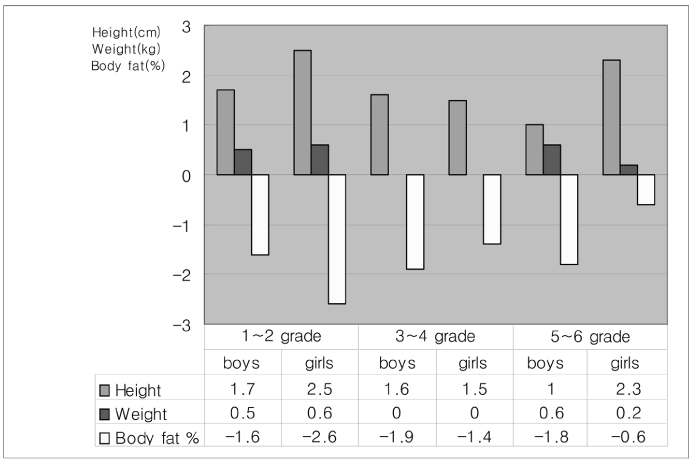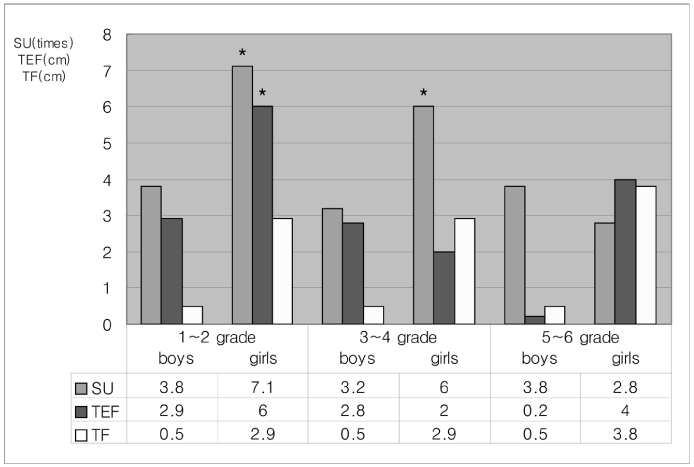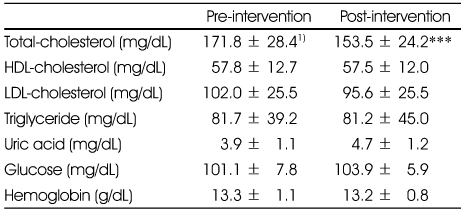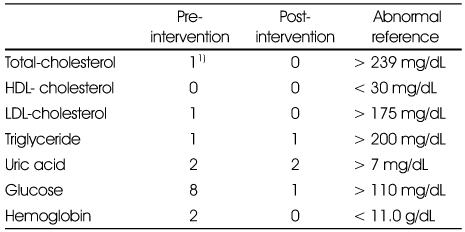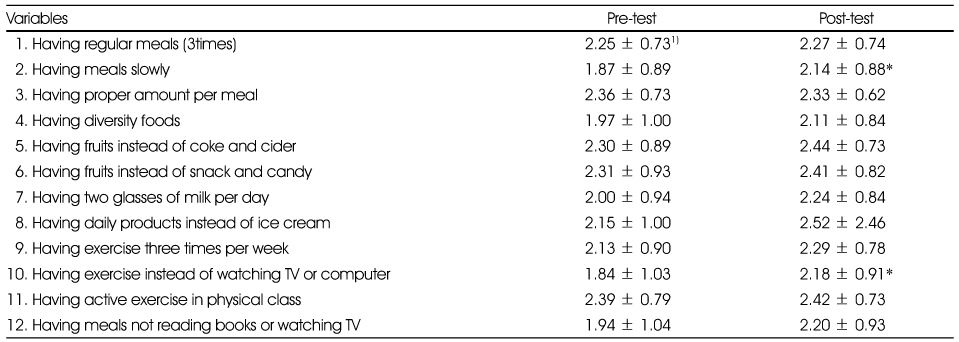References
1. Ahn Y, Ko SY, Kim KW. Evaluation of a nutrition education program for elementary school children. Korean J Community Nutr 2009. 14(3)266–276.
2. Baek SH. The effect of physical activity on children's obesity. Korean J Obes 2008. 17(2)55–64.
3. Bandura A. Foundations of thought and action: A social cognitive theory 1986. Englewood Cliffs, NJ: Prentice-Hall;
4. Green LW, Kreuter MW. Health program planning - An educational and ecological approach 2005. New York: McGraw Hill;
5. Hancox RJ, Milne BJ, Poulton R. Association between child and adolescent television viewing and adult health, a longitudinal birth cohort study. Lancet 2004. 364(9430)257–262.
6. Her ES, Lee SG, Park HJ, Lee KH. Effect-evaluation on nutrition education in related curriculums for elementary school children - Focused on change of dietary habits -. Korean J Community Nutr 2005. 10(6)795–804.
7. Hochbaum GM. Strategies and their rationale for changing people's eating habits. J Nutr Educ 1981. 13(1)59–65.
8. Jung YY, Shin EK, Lee HJ, Lee NH, Chun BY, Ahn MY, Lee YK. Development and evaluation of a nutrition education program on sodium reduction in elementary school students. Korean J Community Nutr 2009. 14(6)746–755.
9. Kim EK, Choi YS, Cho UH, Chi KA. Childhood Obesity of Elementary School Students in Kangnung and Seoul Areas -Effects of Area and Parental Socio-Economic Status. Korean J Nutr 2001. 34(2)198–212.
10. Kim KH. Effects of weight control program on food habits, eating behaviors and life habits in obese elementary school children. Korean J Community Nutr 2009. 14(5)509–520.
11. Koo JO, Lee JW, Choi YS, Kim JH, Lee JH. Life cycle nutrition 2006. Seoul: Hyoilbooks; 229–231.
12. Korea Centers for Disease Control and Prevention. Korea health issue 2007a. Seoul: Korea Centers for Disease Control and Prevention; 61–64.
13. Korea Centers for Disease Control and Prevention. Korean national growth charts 2007b. Korea Centers for Disease Control and Prevention: Seoul; 8–27.
14. Korea Food & Drug Administration. In-depth analysis on the dietary survey of infant, children and adolescents-winter survey 2008. Seoul: 86–100.
15. Lee EJ, Kim KH. Changes of obesity index, serum lipid profiles and nitrient intakes in obese children after the weight control program of nutrition education. Korean J Community Nutr 2010. 15(1)61–72.
16. Lee HS, Choi JS, Kim WY. Effect of nutrition education for weight control on the dietary behavior, anthropometry, body composition, and the serum levels of adipocytokines in the elementary obese children. Korean J Food Cult 2005a. 20(3)323–330.
17. Lee YM, Lee MJ, Kim SY. Effects of nutrition education through discretional activities in elementary school - Focused improving nutrition knowledge and dietary habits in 4th-, 5th, and 6th-grade students. J Korean Diet Assoc 2005b. 11(3)331–340.
18. Lee YS, Lim HS, Ahn HS, Jang NS. Nutrition throughout the life cycle 2006. Seoul: Kyomunsa; 254–256.
19. Lee JY, Lee SY. A comparative study on nutrition knowledge, eating behavior and nutrient intakes for students at elementary schools with and without nutrition education program. J East Asian Soc Diet Life 2004. 14(6)561–570.
20. Ministry of Health Welfare. National Health and Nutrition Examination 2006. The 3rdth ed. Seoul: Ministry of Health Welfare; 181.
21. Ministry of Health Welfare. Health Investment 2007. 01. 26. Seoul:
22. Ministry of Health Welfare. 2007 National Health and Nutrition Examination Korea control of disease control & prevention 2008. Seoul:
23. Ministry of Health Welfare. 2008 Health statistics 2009. Seoul: Ministry of Health Welfare; 48–49.
24. Na SY, Ko SY, Eom SH, Kim KW. Intakes and beliefs of vegetables and fruits, self-efficacy, nutrition knowledge, eating behavior of elementary school students in Kyunggi area. Korean J Community Nutr 2010. 15(3)329–341.
25. Shin EK, Lee HS, Lee YK. Effects of nutrition education program in obese children and their parents-Focus on anthropometric values and serum biochemical index. Korean J Community Nutr 2004. 9(5)566–577.
26. Shin KO, Yoo YY, Park HS. Study on the eating habits and growth development in Korean preschool children. Korean J Nutr 2005. 38(6)455–464.
27. Yi BS. Comparative analysis on meal and food preference between non-obese and obese elementary school chidren. Korean J Food Cult 2007. 22(4)482–491.
28. Yon MY, Hyun TS. Evaluation of nutrition education program for obese children. J Hum Ecol 2007. 11(2)143–151.
29. Yoon GA. Overweight tracking in primary schoolchildren and analysis of related factors. Korean J Nutr 2002. 35(1)69–77.
